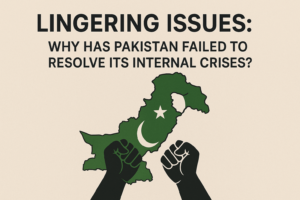Lingering Issues: Why Has Pakistan Failed to Resolve Its Internal Crises?
Overview
Pakistan’s persistent challenges—ranging from governance failures, political instability, economic fragility, and justice delays—continue to hold back national progress. Despite repeated promises by governments and military regimes, structural reforms are delayed or half-hearted. The real test for Pakistan is not identifying problems, but implementing lasting solutions.
Key Outlines
- Introduction — the weight of unresolved issues
- Political instability and institutional mistrust
- Weak governance and administrative inefficiency
- Corruption and lack of accountability mechanisms
- Judicial backlog and delays in justice
- Economic crises — debt, inflation, unemployment
- Social indicators — education, health, poverty
- Security challenges and internal polarization
- Repeated cycles of reform without implementation
- Key facts and figures
- Way forward
- Conclusion
1. Introduction — the weight of unresolved issues
Every state faces challenges, but Pakistan’s misfortune lies in its inability to resolve them. From energy crises to political chaos, problems linger for decades, reappearing under different names.
2. Political instability and institutional mistrust
Frequent power struggles between political parties, judiciary, and military have created mistrust. Governments spend more time in survival than in reform.
3. Weak governance and administrative inefficiency
The bureaucracy, once considered Pakistan’s backbone, is plagued with inefficiency, red tape, and lack of meritocracy. This weakens service delivery.
4. Corruption and lack of accountability mechanisms
Pakistan ranks 133 out of 180 countries in Transparency International’s Corruption Perceptions Index (2024). Selective accountability has eroded trust in institutions.
5. Judicial backlog and delays in justice
With nearly 2.2 million pending cases in courts, justice is delayed and often denied. This weakens rule of law and public trust.
6. Economic crises — debt, inflation, unemployment
- Public debt stands at $240 billion (2025), almost 80% of GDP.
- Inflation remains double-digit, averaging 18% in FY2024-25.
- Unemployment and brain drain continue to rise.
7. Social indicators — education, health, poverty
- Pakistan’s literacy rate: 58% (UNESCO 2024).
- 30% of the population lives below the poverty line.
- Healthcare spending is only 1% of GDP.
8. Security challenges and internal polarization
Terrorism may have reduced, but religious extremism, ethnic divides, and intolerance remain threats to social cohesion.
9. Repeated cycles of reform without implementation
Every government announces reforms in police, civil service, taxation, and education. Yet without continuity, these efforts collapse midway, creating a cycle of unfulfilled promises.

Facts and Figures
- Public debt: $240 billion (2025), 80% of GDP.
- Corruption Perception Index rank: 133/180 (2024).
- Pending court cases: 2 million.
- Literacy rate: 58%.
- Poverty rate: 30%.
- Healthcare spending: 1% of GDP.
Vocabulary with Synonyms/Antonyms
- Lingering – lasting longer than necessary
- Syn: persisting, remaining
- Ant: resolved, ended
- Inefficiency – inability to perform effectively
- Syn: incompetence, inadequacy
- Ant: efficiency, competence
- Polarization – division into conflicting groups
- Syn: division, separation
- Ant: unity, harmony
- Backlog – accumulation of pending tasks
- Syn: pile-up, accumulation
- Ant: clearance, resolution
- Fragility – weakness and vulnerability
- Syn: instability, weakness
- Ant: strength, resilience
CSS-Relevant Analytical Questions
- Why do Pakistan’s structural issues remain unresolved despite decades of reform?
- Evaluate the impact of judicial delays on Pakistan’s democracy.
- How does political instability affect economic governance?
- Discuss the link between corruption and Pakistan’s low social development indicators.
- Suggest reforms that can permanently address Pakistan’s governance crisis.
MCQs for Practice
- Pakistan’s rank in Transparency International’s Corruption Perception Index (2024) was:
a) 120
b) 133
c) 142
d) 150
Answer: b - How many pending cases are there in Pakistan’s judiciary?
a) 1.2 million
b) 2.2 million
c) 3.1 million
d) 4.5 million
Answer: b - What percentage of Pakistan’s GDP is spent on healthcare?
a) 1.1%
b) 2.5%
c) 3.7%
d) 5%
Answer: a - Pakistan’s literacy rate in 2024 was approximately:
a) 58%
b) 65%
c) 72%
d) 80%
Answer: a - Pakistan’s total public debt in 2025 is estimated at:
a) $120 billion
b) $180 billion
c) $240 billion
d) $300 billion
Answer: c
Way Forward
- Strengthen political consensus through charter of democracy.
- Reform bureaucracy with merit-based recruitment and accountability.
- Increase judicial capacity to clear backlog.
- Enhance tax reforms to reduce debt dependency.
- Invest in education and health to improve human capital.
- Promote institutional continuity across governments.
Conclusion
Pakistan’s “lingering issues” stem not from lack of awareness but from lack of will and continuity. Unless political leadership prioritizes reform over power struggles, the country will remain trapped in recurring crises. The way forward lies in consistent governance, institutional trust, and investment in people—without which Pakistan’s potential will always remain unfulfilled.

